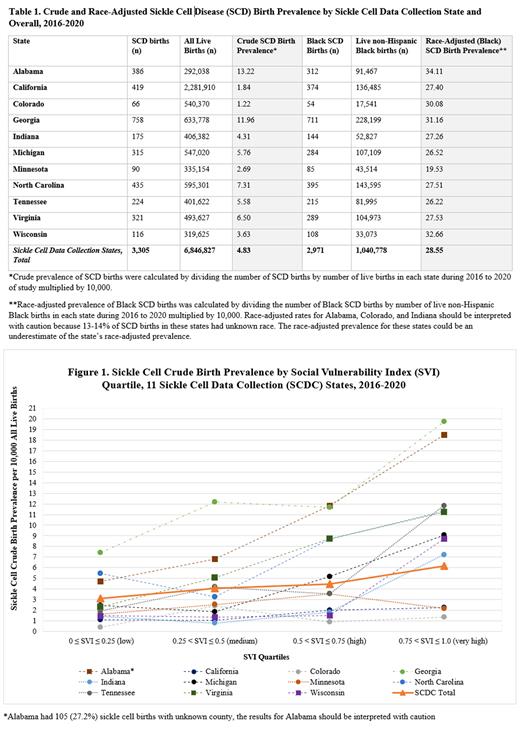Introduction
Despite national implementation of universal newborn screening for sickle cell disease (SCD) since 2006, data on the prevalence of SCD births in the United States are scarce. Updated prevalence data by geographic location are needed to guide the allocation of resources and to connect newborns to comprehensive SCD care. The purposes of this study were to describe the 1) crude and race-adjusted SCD birth prevalence and 2) crude SCD birth prevalence by quartiles of the social vulnerability index (SVI, CDC, 2020) in 11 Sickle Cell Data Collection (SCDC) program states (Alabama, California, Colorado, Georgia, Indiana, Michigan, Minnesota, North Carolina, Tennessee, Virginia, and Wisconsin).
Methods
This retrospective cohort study used newborn screening (NBS) records from 2016 to 2020. Births were included if they were confirmed SCD births and the mother's county of residence at the time of birth was in an SCDC state. Mother's county and newborn's race, ethnicity, sex, date of birth, and genotype were extracted from NBS records or birth certificates, if available. Crude SCD birth prevalence per 10,000 was calculated by dividing the cumulative number of SCD births by the cumulative number of all live births from 2016 to 2020 and multiplying by 10,000. Race-adjusted SCD birth prevalence was calculated by dividing the cumulative number of Black SCD births by live non-Hispanic Black (NHB) births from 2016 to 2020 and multiplying by 10,000. Frequency of all births and NHB births were obtained from each state's health department.
County characteristics were quantified by the SVI using the 2020 state-ranked CDC/ATSDR SVI datasets (CDC, 2020) and were matched to mother's county of residence at birth. SVI ranks counties on 16 social factors, including unemployment, minority status, and disability. Ranks were grouped into SVI quartiles: low (0 ≤ SVI ≤ 0.25), medium (0.25 < SVI ≤ 0.5), high (0.5 < SVI ≤ 0.75) and very high (0.75 < SVI ≤ 1.0) vulnerability. Crude SCD birth prevalence was calculated for each SVI quartile.
Results
From 2016 through 2020, there were 3,305 newborns with SCD across 11 SCDC states [ 49.6% male, 89.8% Black]. Georgia had the highest number of births (n=758) followed by North Carolina (n=435), California (n=419), and Alabama (n=386). The majority (57.0%) had Hb SS or Hb S Beta 0 thalassemia, 27.9% had Hb SC, and 9.6 % had Hb S Beta + thalassemia or other SCD type.
The crude SCD birth prevalence ranged from 1.22 to 13.22 per 10,000 live births. The race-adjusted SCD birth prevalence for SCDC states was 28.55 per 10,000 or 1 in every 350 NHB births. Race-adjusted birth prevalence varied among states ranging from 19.53 to 34.11 per 10,000 NHB births (Table 1).
Overall, the majority (67%) of mothers of newborns with SCD resided in high or very high social vulnerability counties (Figure 1). Except for Colorado, where the highest crude SCD birth prevalence was among mothers residing in medium social vulnerability counties, the remaining 10 SCDC states had the highest prevalence among mothers residing in high or very high social vulnerability counties.
Limitations include using the mother's reported race for all births to calculate race-adjusted birth prevalence. Additionally, because of missing data on ethnicity for SCD births, we used all Black SCD births, rather than non-Hispanic Black SCD births, to calculate the race-adjusted SCD birth prevalence. Despite the limitations, the study provides crude and race-adjusted SCD birth prevalence data from 11 states in the South, Midwest, and Western United States, covering an estimated one third of the SCD population in the United States. Furthermore, providing the crude prevalence of SCD births by SVI quartile adds valuable information on county-level characteristics that might influence health outcomes for newborns with SCD.
Conclusions
The race-adjusted birth prevalence for SCD remains stable from previous estimates at 1 in every 350 BNH births. The finding that most mothers of newborns with SCD reside in high and very high social vulnerability counties at the time of birth underscores the importance of assessing social determinants of health (SDOH) that may impact health outcomes for newborns with SCD. Findings from this report can be used to guide state- and county-level programs that address SDOH for people with SCD and have implication for clinicians who must incorporate screening for SDOH in their practice and refer families to community resources as needed.
Disclosures
Rothman:Pfizer: Consultancy, Honoraria, Research Funding; Agios Pharmaceuticals, Inc.: Honoraria, Research Funding; Novartis: Honoraria, Research Funding; bluebird bio: Research Funding. Strouse:Agios, Takeda, Disc Medicine: Consultancy, Research Funding. Horiuchi:Bio-Rad: Current equity holder in publicly-traded company; Natera: Current Employment, Current equity holder in publicly-traded company; Roche: Ended employment in the past 24 months.


This feature is available to Subscribers Only
Sign In or Create an Account Close Modal